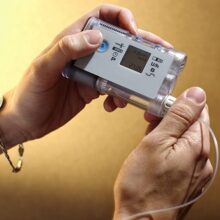Automatic Hybrid Insulin Delivery Systems Help Manage T1D

Advanced hybrid closed-loop (AHCL) systems improve glycemic control in patients with type 1 diabetes, according to a prospective evaluation by 16 diabetes specialists in Spain. The current hybrid closed-loop systems have gone one step further by mimicking the body’s natural insulin delivery systems.
The objective of this evaluation was to analyze the results of two AHCLs currently on the market (MM780G with SmartGuard and Tandem t:slimX2 with Control-IQ) and to determine their real-life benefits, based on the information provided by the patients.
“The evaluation involved 150 patients from 14 centers, 75 for each system, and lasted for 3 months. An initial evaluation was carried out, and another was done at the end of the 3 months to determine diabetes control and user satisfaction. Glycosylated hemoglobin (HbA1c), time in different glycemic ranges, and patient-reported outcomes were assessed. To take quality of life into consideration, a 146-point questionnaire was completed to assess all aspects of the condition at a later stage,” Pilar Beato, MD, specialist in endocrinology and nutrition at Badajoz University Hospital in Spain, told Univadis Spain.
The study enrolled adolescent and adult men and women with type 1 diabetes who had not previously been treated with AHCL. After analysis of the results, the specialists concluded that the two AHCLs provide a significant improvement in glucose control. Neither AHCL was superior. Interestingly, the improvement in diabetes-related anxiety was the greatest in Control-IQ users. But there were no differences in improvement in sleep quality.
Beato, the lead study author, said that “there have been other previous analyses, but none with a prospective joint assessment with the same design. Our results demonstrate that both systems are highly effective, reduce glycosylated hemoglobin, and improve all quality-of -life parameters evaluated. The results are comparable as different health centers took part. All experts taking part belong to the Spanish Diabetes Society’s applied technology in diabetes task force. The choice of which AHCL to use will depend on the specialists and availability at each site. User preferences should also be considered as the devices may have individual features making one or the other more convenient for a given individual. But based on our data, there is no clinical indication to choose one over the other.”
The concept of the two systems analyzed is the same: They both have a glucose sensor that is constantly taking measurements, and both send the information in real time to the system algorithms that decide how much insulin should be supplied, thereby controlling glucose highs and lows. They differ in the design of the system components and in the engineering of the algorithms. But the important thing is that the information for managing an individual’s diabetes and the amount of insulin they need is obtained from the patient himself or herself. Making the systems automated addresses and corrects glucose variability itself even within a single day, as multiple factors such as food, nerves, or sports can affect glucose levels.
“Initial training and support are needed in the event of an incident or problem, but it does not necessarily require more consultation time as they are automated systems and are capable of automatically resolving glucose spikes that may occur in an individual. This may even involve less consultation time. Naturally, patients must continue to be monitored by endocrinology with some regularity,” said Beato.
These technologies are endorsed by international scientific societies that are seeing more and more advantages of such devices. The societies therefore recommend that closed-loop hybrid systems be the standard of care in people with type 1 diabetes as they are more effective than conventional multidose insulin therapy. They have been recommended by the American Diabetes Association since 2022 and the National Institute for Health and Care Excellence guidelines since January 2023, among others.
Beato regrets that the use of these devices is not widespread in Spain. “We don’t have data about the percentage of people using them, but we get the impression that this number is low and not enough. We need a boost and to break down some barriers such as cost. The devices will ultimately reduce the cost of diabetes control as they are designed to provide better glucose control. They will reduce admissions for complications such as diabetic retinopathy or hypoglycaemia. They will also reduce absence from school and work. In the future, I’m sure the systems will be smaller, which will suit users better.”
This article was translated from Univadis Spain, which is part of the Medscape Professional Network.
